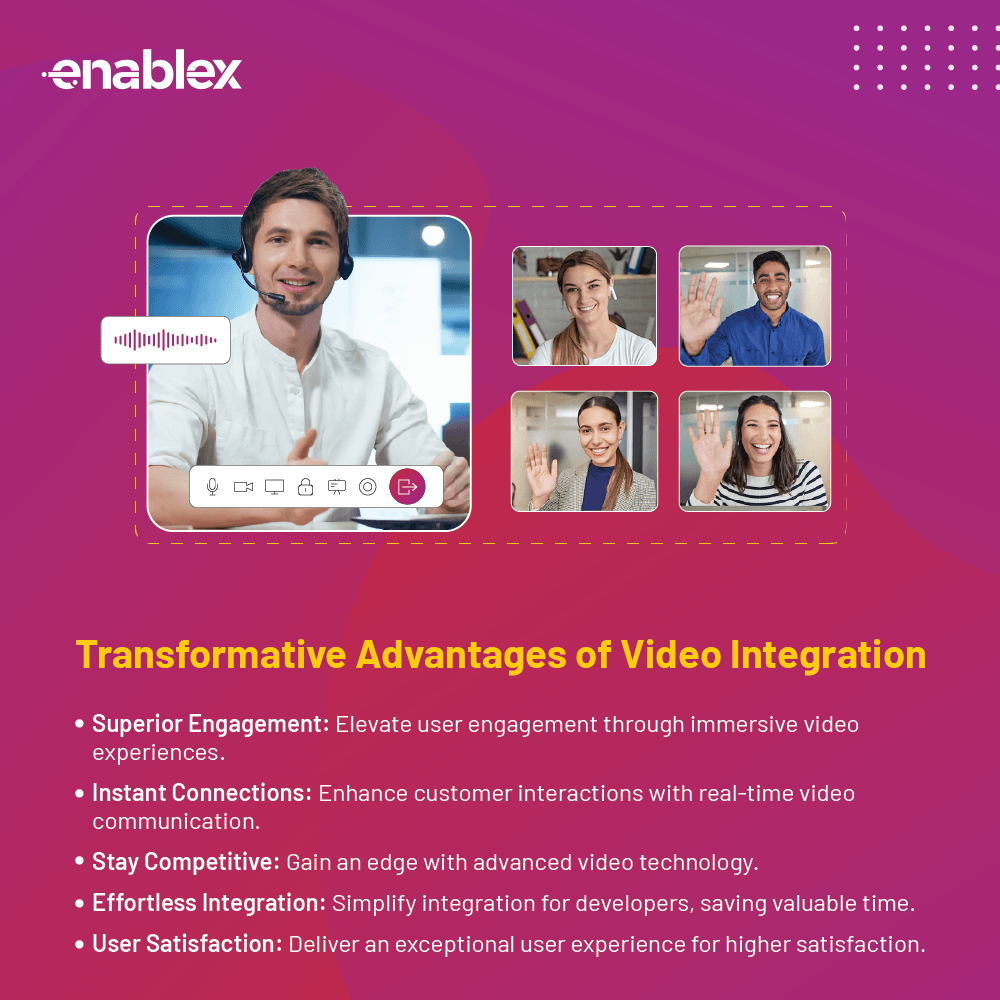Video calling has become more than just a convenience – it’s a cornerstone of communication and collaboration. Whether it’s connecting with colleagues across the globe, staying close to family, or engaging students in remote learning, video calls have revolutionized the way we interact. However, building a robust video calling experience requires more than just a webcam and a microphone. That’s where Video Calling SDK and APIs come in, providing developers with the tools to seamlessly integrate video conferencing into their applications.

What are Video Calling SDKs and APIs?
- SDK (Software Development Kit): An SDK is a collection of pre-built code libraries, tools, and documentation that simplifies video calling integration into your application. It provides the building blocks, like audio/video capture, encoding/decoding, and network communication, to handle the technical complexities of video calls.
- API (Application Programming Interface): An API acts as a bridge between your application and the video calling service. It exposes a set of functions and commands you can use to control various aspects of video calls, such as joining sessions, managing participants, and adding features like screen sharing and recording.
Why Use SDKs and APIs?
- Building video calling functionality from scratch is a complex and time-consuming task. SDKs and APIs bridge this gap by offering several key advantages:
- Faster Development: They significantly reduce development time by providing pre-built solutions for core video call functionalities.
- Reduced Costs: You avoid the need for specialized video communication expertise within your team.
- Scalability and Flexibility: SDKs and APIs offer the ability to scale your application to accommodate large numbers of users and integrate advanced features.
- Enhanced User Experience: You can easily incorporate features like high-quality audio/video, low latency, and security protocols, leading to a smooth and reliable user experience.
Exploring Key Features and Functionalities of Video Calling SDKs and Video API:
Video SDKs and Video call APIs offer a wide range of features to cater to diverse needs. Here are some of the most common:
- Basic Video Calling: Initiate and manage one-on-one or group video calls with ease.
- Audio/Video Capture and Encoding: Capture audio and video from cameras and microphones and encode them for efficient transmission over the internet.
- Network Management and Communication: Handle network connections, data exchange, and routing between participants.
- Security and Encryption: Employ encryption protocols to ensure secure communication and privacy.
- Screen Sharing: Allow participants to share their screens for presentations, collaboration, or remote assistance.
- Call Recording: Record video calls for future reference or training purposes.
- Live Annotations and Whiteboard: Facilitate real-time collaboration with interactive tools like annotations and whiteboard functionality.
- Virtual Backgrounds and Filters: Enhance the visual experience with fun and practical features like virtual backgrounds and filters.
Choosing the Right Video SDK or API:
With a plethora of options available, selecting the right video calling solution can be overwhelming. Here are some factors to consider:
- Target Platform: Choose an SDK or API compatible with your development platform (e.g., Android, iOS, web).
- Scalability and Pricing: Consider your user base and future growth and choose a solution with flexible pricing plans and scalability options.
- Feature Set: Identify the features crucial for your application and ensure the chosen Video SDK or API offers them.
- Ease of Use: Evaluate the documentation, support resources, and developer community available for smooth integration and troubleshooting.
- Security and Privacy: Prioritize solutions with robust security protocols and data privacy compliance features.
Getting Started with Video API and Video SDK Implementation:
Once you’ve chosen an SDK or API, follow the provided documentation for integration. Typically, the process involves:
- Setting Up Account and Credentials: Register with the chosen service provider and obtain API keys or access tokens.
- Downloading and Installing the SDK: Download the appropriate SDK for your platform and install it into your development environment.
- Integrating the SDK into your Application: Use the provided APIs and code libraries to implement video call functionalities within your application.
- Testing and Debugging: Thoroughly test your application for functionality, performance, and user experience.
Video Calling APIs offer a robust solution for developers aiming to integrate video calling features into their applications. Understanding the key features, integration processes, and addressing common concerns through FAQs ensures a smoother development experience. As video communication continues to evolve, harnessing the power of Video Calling SDKs and APIs becomes essential for delivering rich and immersive user experiences in the digital realm.
FAQs
Q: What platforms do Video Calling SDKs and APIs support?
Most solutions provide cross-platform support, including mobile, web, and desktop platforms. Ensure your chosen tool is compatible with your target platform.
Q: Does using an SDK or API affect my app’s performance?
Properly implemented video calling functionality shouldn’t significantly impact your app’s performance. Choose a provider with a reputation for optimized solutions.
Q: Can I customize the video call interface?
This depends on your chosen tool. Some SDKs offer limited customization options, while APIs give you more freedom to design the interface to match your app’s look and feel.
Q: What are the security risks of using Video Calling SDKs and APIs?
Choose a provider with robust security measures like data encryption, secure authentication, and regular security audits. Be vigilant about updating your app and the video calling solution to ensure the latest security patches are applied.
Q: Are there free video calling SDKs and APIs?
Yes, several free options exist with varying feature sets and limitations. Researching and comparing different providers is crucial.

